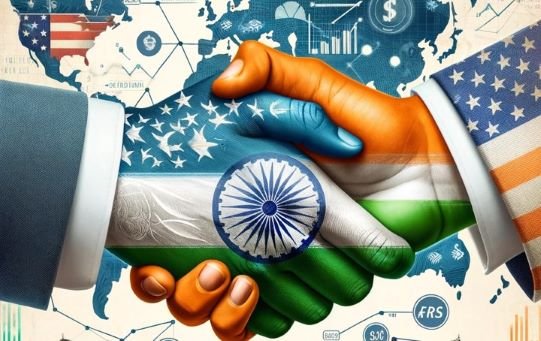India – Trade, Tariffs, and Diplomacy
As Prime Minister Narendra Modi prepares for a high-stakes meeting with former US President Donald Trump, India finds itself in a complex but somewhat favorable position in trade negotiations. While Trump has repeatedly targeted several countries—including China, Mexico, and Canada – with tariffs and trade restrictions, India has thus far managed to stay off his immediate radar.
The upcoming meeting between the two leaders will not only define the trajectory of India-US relations but also shape India’s role in the evolving global trade landscape. Despite being labeled the “tariff king” by Trump in the past, India’s diplomatic approach, policy shifts, and trade concessions could help it avoid the worst of any potential trade war.
India’s Strengths in the Trade Negotiations
While India’s economy has faced challenges, trade analysts believe the country is in a relatively strong position ahead of the Modi-Trump discussions. Milan Vaishnav, Senior Fellow and Director of the South Asia Program at the Carnegie Endowment for International Peace, suggests that India’s ability to navigate diplomatic waters effectively has helped maintain a balanced relationship with Washington.
One of the key reasons for this optimism is that, despite Trump’s campaign rhetoric, he has not imposed major trade penalties on India. This is in stark contrast to his aggressive tariff measures against China, which have significantly impacted global trade dynamics.
Furthermore, India’s position in the Indo-Pacific strategic alliance, particularly as a member of the Quad (alongside the US, Japan, and Australia), is an important factor. US Secretary of State Marco Rubio’s first diplomatic engagement after assuming office was with the Quad, signaling India’s growing geopolitical importance in Washington’s strategic calculus.
Trade Concessions and Political Calculations
The Modi government has also made calculated moves to appease the Trump administration on key issues.
- Tariff Reductions: India has lowered tariffs on Harley-Davidson motorcycles and may follow suit with pecan nuts and bourbon whiskey, two industries that hold political significance in the US.
- Immigration Policies: The repatriation of undocumented migrants from the US to India via a military aircraft landing in Amritsar signals cooperation on border enforcement.
- Technology and Market Access: Unlike China, India has given US tech firms relatively free access to its markets, making it a key growth destination for companies such as Amazon and OpenAI.
Balancing Economic Ties with Defense and Energy Agreements
Beyond trade, India has made notable shifts in its defense and energy procurement strategies to strengthen ties with the US:
- Reduced Dependence on Russia: India has significantly cut back on arms imports from Russia, opting instead to purchase more defense equipment from the US.
- Nuclear Energy Investments: The recent amendment of India’s nuclear liability laws and the push for 100 gigawatts of nuclear power capacity create new business opportunities for US firms like GE and Westinghouse.
These moves indicate that India is willing to engage in deeper economic and security cooperation with the US, which could serve as a counterbalance to concerns over trade deficits.
Challenges Remain: India’s Trade Deficit with the US
Despite these diplomatic overtures, India’s trade deficit with the US reached a record $45.7 billion in 2024, making it the 11th largest trade deficit Washington faces. While not as significant as the US-China trade gap, it remains a powerful negotiating tool in Trump’s hands.
Experts predict that Trump may push harder for increased LNG and defense exports to India in a bid to reduce the deficit. Additionally, concerns persist over potential curbs on legal immigration, with debates ongoing about restrictions on H1B visas despite opposition from major tech companies like Tesla and SpaceX.
Geopolitical Risks and the China Factor
Another emerging concern is the US-China relationship and its potential impact on India. There are growing apprehensions in New Delhi’s foreign policy circles that the US and China could eventually reach a “G2” accommodation, sidelining India in key economic and security discussions.
Adding to this uncertainty is the influence of Elon Musk, whose business interests in China (where Tesla sells over a third of its cars) could shape the Trump administration’s stance towards Beijing.
Possible Outcomes of the Modi-Trump Meeting
While expectations for a comprehensive trade agreement remain tempered, the meeting between Modi and Trump could yield progress on:
- Civil nuclear cooperation renewals
- Enhanced defense collaborations
- Limited trade agreements to ease tariff tensions
According to Bloomberg’s Sudhi Ranjan Sen, who is closely tracking the developments, both sides are actively accumulating bargaining chips ahead of the discussions. The Adani bribery case could also feature as a negotiation leverage, shaping the tone of the engagement.
Despite these complexities, the Modi-Trump relationship appears poised to endure.
As the world watches, India will need to strike a careful balance between diplomatic tact, economic concessions, and long-term strategic positioning to navigate what could be one of its most consequential trade discussions in recent years.
Also see:
Auspicious Amrit Snan at Maha Kumbh 2025
Blue Origin New Glenn Rocket Launch Delayed
China Considers TikTok US Sale to Elon Musk
Maha Kumbh Mela 2025: A Historic Convergence of Devotion and Tradition
—————————————————————
It would mean the world to us if you follow us on Twitter, Instagram and Facebook




